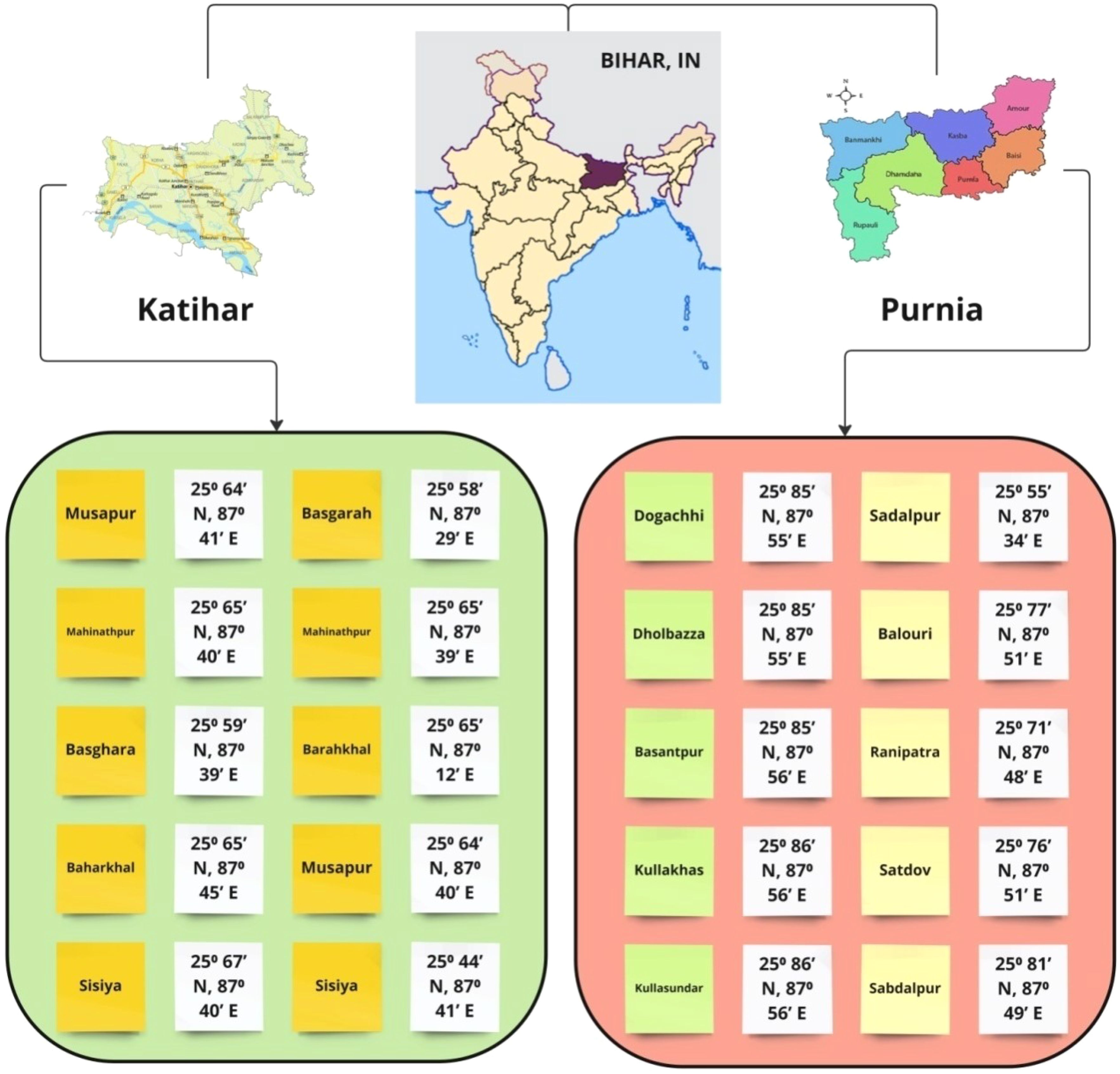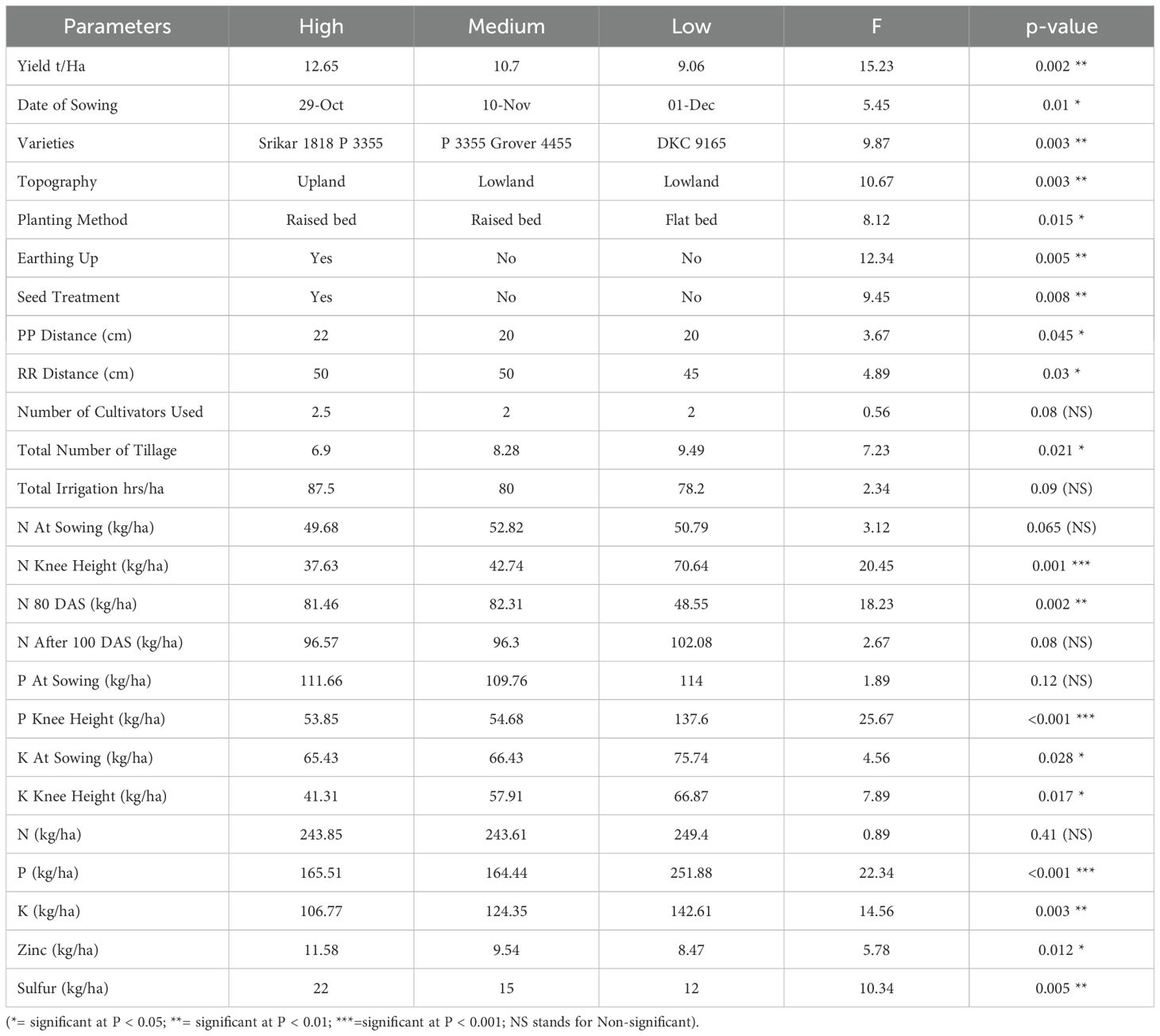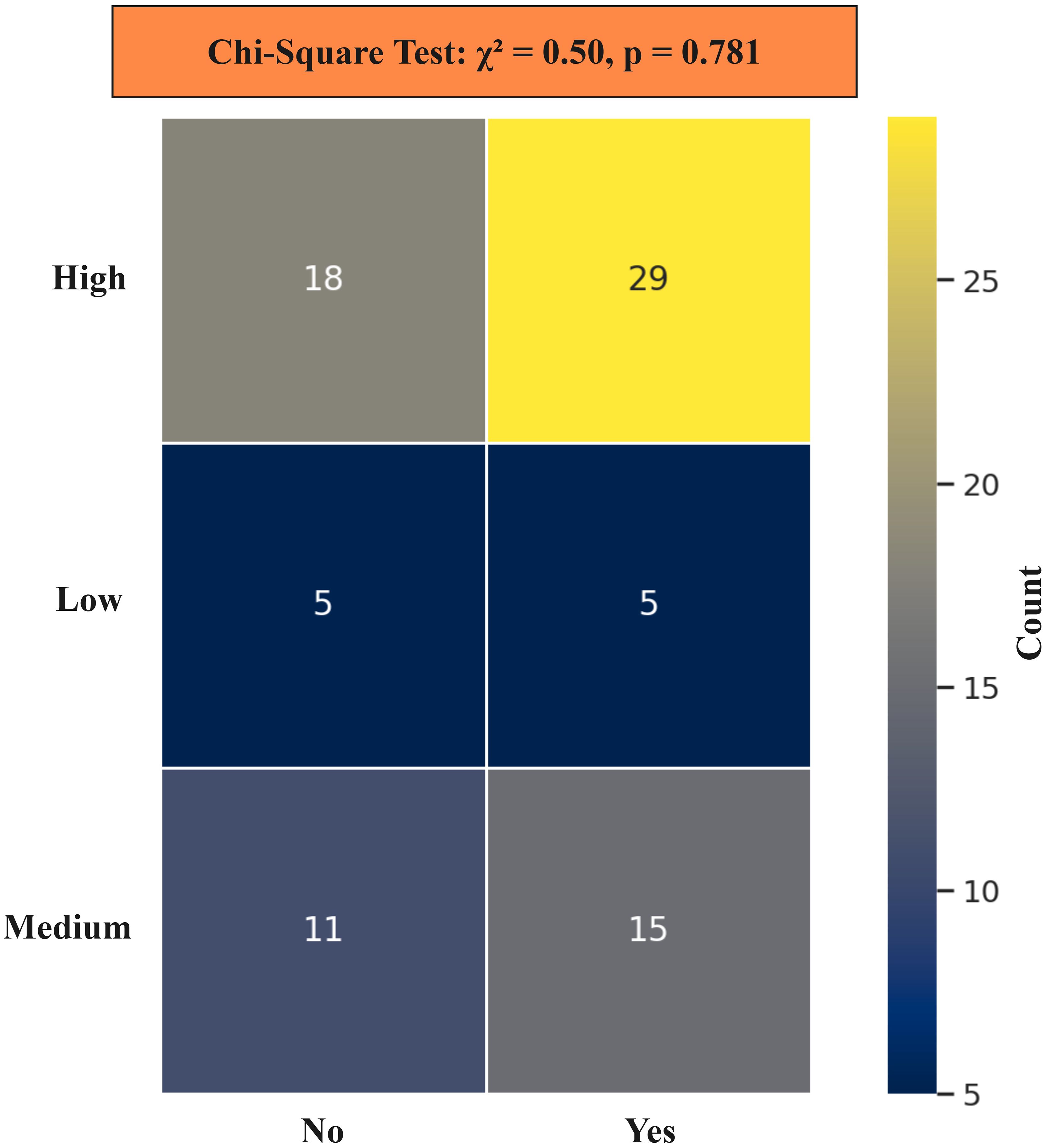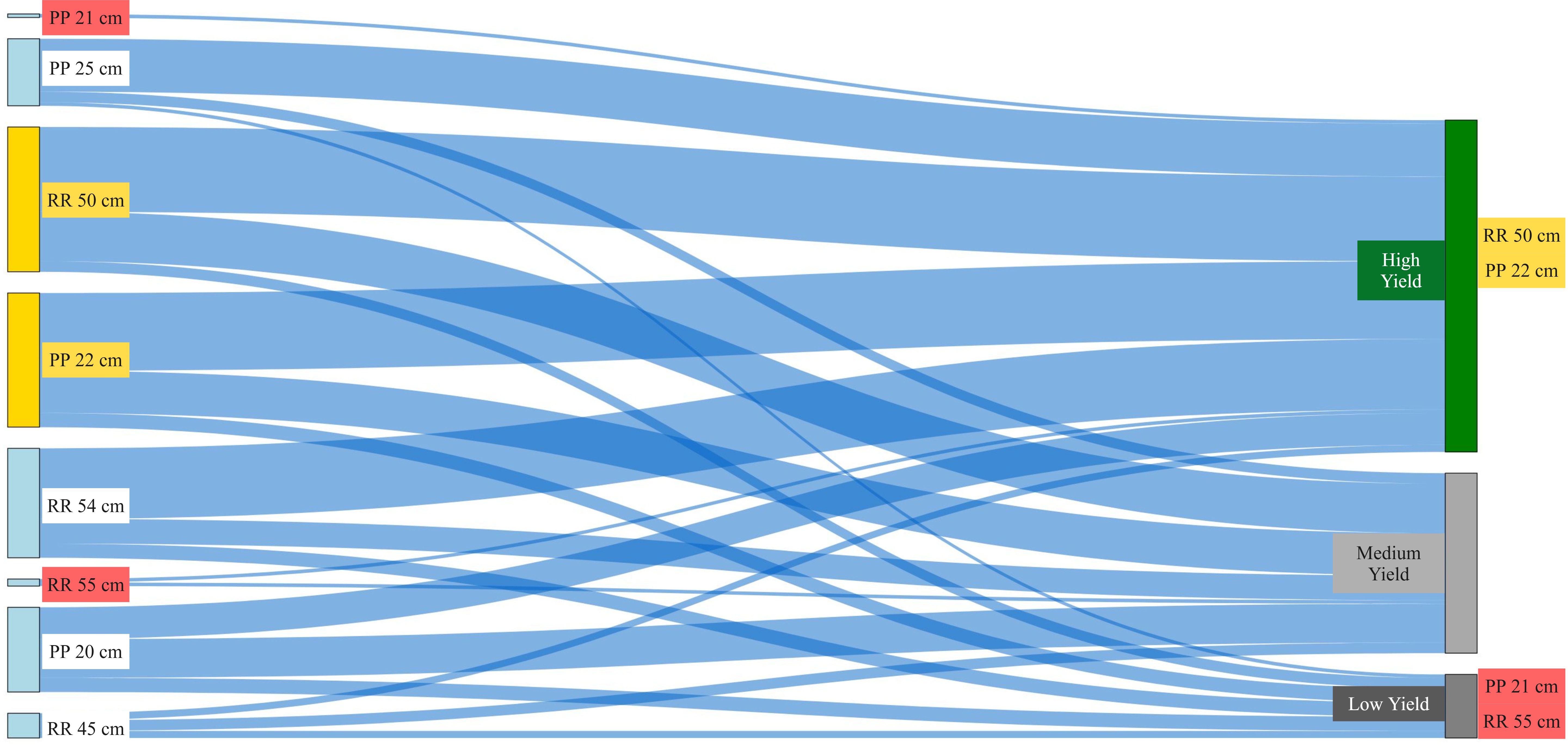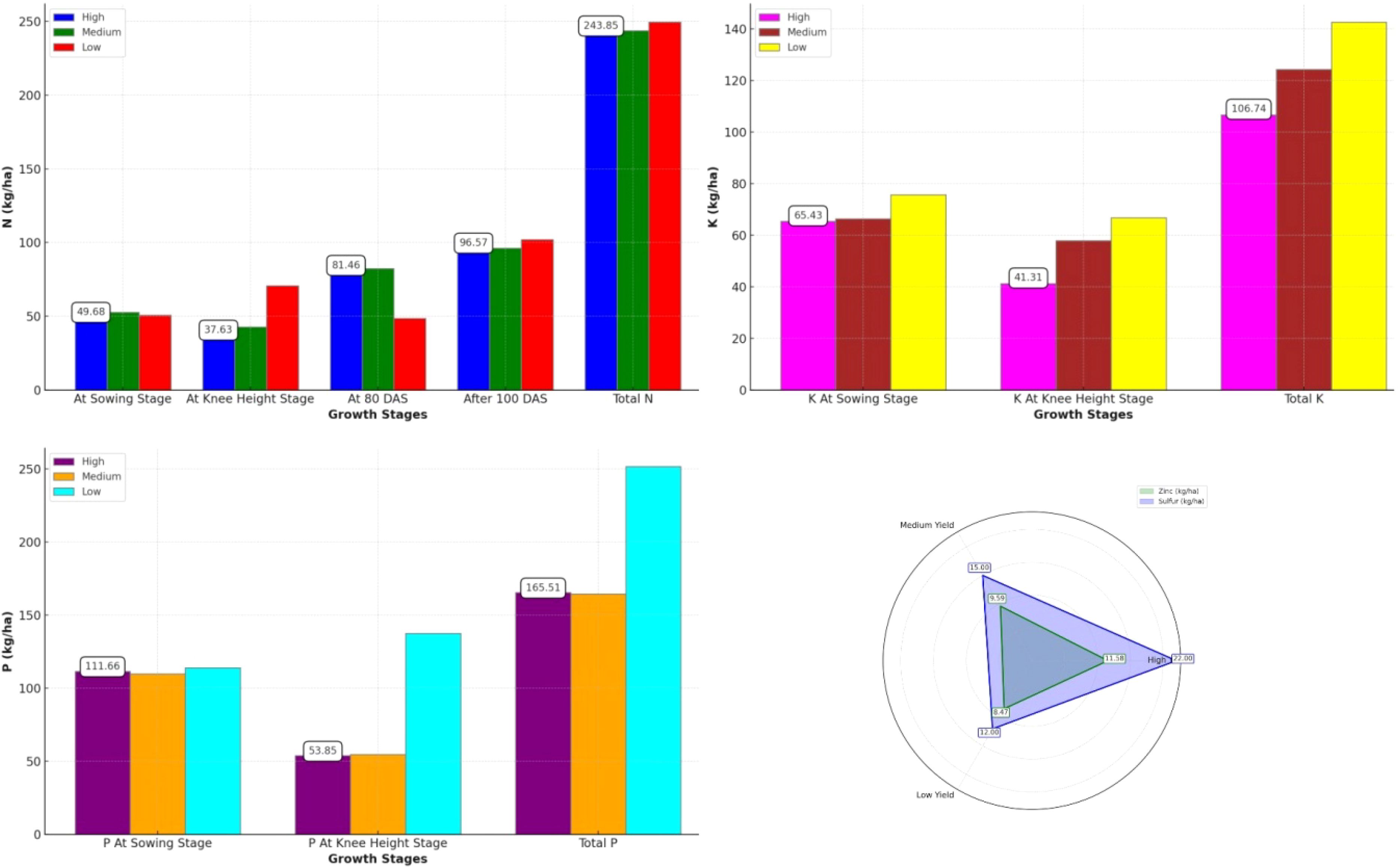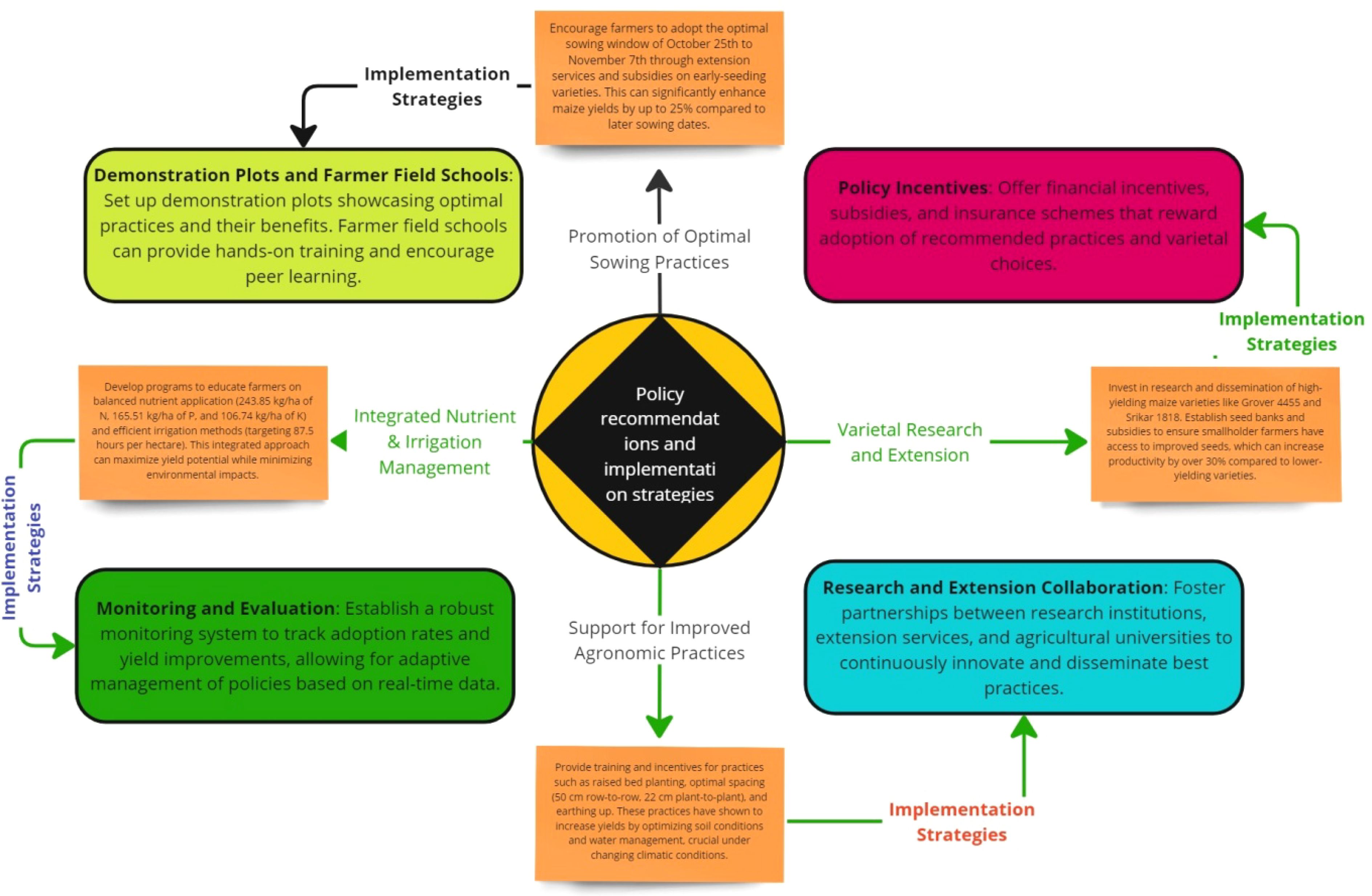- 1Borlaug Institute for South Asia (BISA), Samastipur, Bihar, India
- 2ICAR-Indian Agricultural Research Institute, Regional Station, Samastipur, Bihar, India
- 3Bihar Agricultural University, Bhagalpur, Bihar, India
- 4Dr. Rajendra Prasad Central Agricultural University, Samastipur, Bihar, India
- 5Krishi Vigyan Kendra, Katihar, Bihar, India
- 6Krishi Vigyan Kendra, Bikramganj, Bihar, India
- 7Krishi Vigyan Kendra, Jalalgarh, Bihar, India
- 8Krishi Vigyan Kendra, Harnaut, Bihar, India
- 9Bhola Paswan Shastri Agricultural College, Purnea, BAU, Bihar, India
- 10ICAR-Research Complex for Eastern Region, Patna, Bihar, India
- 11Department of Agriculture, Government of Bihar, Bihar, India
What are the key factors influencing yield in winter maize cultivation under adverse climatic conditions? How can on-farm experimentation reveal innovative strategies to improve production in these challenging environments? Four year (2020-21-to-2023-24) on farm experimentation at 160 farmers in the districts of Purnia and Katihar were consider for study. The key factors evaluated for maize yields encompassed sowing windows, varietal performance, topography, seed treatment, earthing up, planting methods, spacing, tillage practices, irrigation, and nutrient management. Data was collected using a structured questionnaire that was validated by visiting on-farm experimentation at fields. Results indicated that the optimal sowing window for high yields was October 25th to November 7th, with high-yielding varieties Grover 4455 and Srikar 1818 showing the best performance. Topography showed a preferential distribution of yield towards upland areas. The variety P3355 demonstrated consistent performance, appearing across both high and medium yield categories. Higher frequencies of high yields in seed-treated plots were nevertheless obtained, with 62% high yields obtained in treated plots against 48% obtained in plots without treatment. At earthing up is one of the critical practices in flat bed system (FBS), and it contributed much to higher yields (χ²=17.86, p=0.003), but in raised bed system (RBS), which allow superior yields intrinsically. This trial showed that optimum spacing of 50 cm row-to-row and 22 cm plant-to-plant, coupled with moderate tillage operations of 4-10, with a median of 6, resulted in increased yields. Efficient irrigation management, where high-yielding plots received balanced nutrient applications of 243.85-165.51-106.74 NPK kg/ha, was a critical factor in realizing high yields. Principal component analysis (PCA) underlined the role of integrated agronomic practices in maximizing maize production. It provides actionable insight to farmers with respect to maize yield improvement for economic resilience and sustainable agriculture. Overall, this study identified optimal sowing windows, high-yielding varieties, and integrated agronomic practices that significantly enhance winter-maize production under adverse climatic conditions, offering actionable insights for sustainable agriculture.
1 Introduction
Maize (Zea mays L.) is one of the most important cereal crops globally, playing a vital role in agri-food security and sustainable agriculture. It serves as a key source of nutrition for millions of people, a staple component of animal feed, and a raw material for numerous industrial applications. Thus, maize has great adaptability to diverse agro-climatic conditions. Currently, global maize production stands at approximately 1.2 billion metric tonnes as of 2023, with the United States (389.7 million tonnes), China (288.8 million tonnes), and Brazil (131.9 million tonnes) being the top producers (FAO, 2023). Nevertheless, maize demand is still increasing due to a growing human population, diet changes, and fuel ethanol production processes (Shiferaw et al., 2011). Maize productivity differs significantly across different regions of the globe. In the United States, high agronomic practice backed by adoption of biotechnology pushed the average yields up to about 10.5 tons per hectare. Average yields, in contrast, have been less than 2 tons per hectare in sub-Saharan Africa, as most farmers lack proper seeds, fertilizers, and adequate irrigation facilities. This yield gap is especially prominent in developing countries, where the adoption of best agronomic practices holds significant potential to enhance productivity (Vanlauwe and Giller, 2006; Brown and Lee, 2019). In spite of its importance, maize production is greatly hampered by climate change, which encompasses rising temperatures, shifting rainfall patterns, and increased extreme weather events. These climatic stresses can significantly reduce maize yields, posing serious threats to agri-food and nutritional security, as well as economic stability across various regions of the world. In India, “winter maize” refers to maize grown during the rabi season (October–March) after rice harvest. Compared to kharif maize, it benefits from longer sunshine hours and lower pest pressure, resulting in higher yields. However, it depends on assured irrigation and is vulnerable to delayed sowing and terminal heat stress (Tuti et al., 2022). In Bihar and eastern India, its rapid adoption is driven by potential gains in cropping intensity and income, yet region-specific agronomic practices remain underutilized and poorly documented. Therefore, adopting adaptive practices (resilient variety selection and optimized sowing schedules) is crucial to sustain production and ensure agri-food availability under climate stress (Shiferaw et al., 2011; Cassman et al., 2003). The need is acutely felt to increase maize farming productivity to meet the growing global demand.
Agronomic research should therefore be conducted to ascertain the best time for sowing, appropriate crop variety, and topography effects on yield. Optimal agronomic practices such as seed treatment, earthing up, appropriate spacing, tillage operations, irrigation, and fertilizer application play crucial roles in enhancing crop yields within sustainable production systems (Kumari et al., 2020). Attempts by various authors to study solo or combine factors affecting maize production have been on several fronts. For instance, it has been shown that timely sowing can lead to better yields due to excellent weather conditions at times during the growing season. Similarly, the choice of high-yielding and disease-resistant varieties can have enormous effects on productivity. Few studies, though, have combined these aspects in a coherent general framework that can therefore help provide useful and relevant advice to practitioners. What makes the present study different is that maize production has been taken from a holistic perspective by considering various interrelated factors bearing on crop yield. The approach establishes the interaction of the parameters with one another and their combined effect on maize production, hence filling this gap in research. In the current research, variables are of an agro-climatic nature to ensure that recommendations made are pertinent and feasible at local levels for farmers. This study aligns with the UN Sustainable Development Goal 2: Zero Hunger, by highlighting key factors affecting maize yield and offering practical recommendations for optimizing production. The findings can support agricultural extension efforts aimed at enhancing food security and economic sustainability in maize-growing regions. This study addresses critical gaps in current maize production research, particularly the lack of integrated assessments that examine how agronomic factors interact to influence yields. It hypothesizes that optimized sowing schedules and resilient maize varieties will significantly improve yields compared to conventional practices, and that adaptive interventions like improved irrigation and nutrient management can reduce climate-related yield losses. The study’s objectives are to: (i) evaluate the combined effects of key agronomic factors and climate variability on maize yields, and identify effective adaptive practices; and (ii) develop practical, farmer-friendly recommendations and assess the economic viability and sustainability of optimized maize production strategies to enhance food security.
2 Methods
2.1 Project sites
The research was carried out in the Purnia and Katihar districts of Bihar, India, with the participation of 160 farmers, evenly divided between the two areas critically reviewed their agronomic practices and the impact on maize yields. This comprehensive analysis allows us to provide targeted recommendations for optimizing maize production in these regions (Figure 1).
2.2 Seed treatments
Application of both fungicides and insecticides to enhance early crop establishment and protect against soil- and seed-borne threats. Specifically, fungicides (thiram and bavistin) were used to prevent fungal infections during germination, while a combination of insecticides (thiodicarb and imidacloprid) was applied to protect seedlings from early-stage insect pests.
2.3 Farmer selection
A total of 160 farmers were purposively selected in consultation with local agricultural officers and Krishi Vigyan Kendras (KVKs) of Purnia and Katihar districts, with 80 farmers from each. The selection was based on multiple criteria, including active involvement in winter maize cultivation over the past three years, willingness to participate in on-farm research trials and provide detailed field-level information, representation of diverse topographic conditions (upland and lowland), and the use of both raised bed and flatbed planting methods. To ensure broad representativeness, farmers were chosen from different blocks and villages within each district, capturing spatial variation and diverse agronomic practices.
2.4 Data collection and analysis
The data collection framework included designing and pre-validating detailed questionnaires on agronomic practices, refined based on farmer feedback. Over 110 days, field teams conducted face-to-face interviews. Farmers were classified into high, medium, and low yield groups using quantile-based stratification of four years of maize yield data. The top ≥75th percentile was considered high-yielding, the 25th–75th percentile as medium, and ≤25th percentile as low-yielding. Descriptive statistics (mean, median, standard deviation) were calculated for each group. To assess yield differences under varying agronomic conditions, ANOVA was used, followed by post-hoc comparisons where necessary to determine statistical significance.
3 Results
3.1 Effect of sowing window
Data indicated that maize planted between October 25th and November 7th consistently yielded above 12 t/ha, with several instances peaking at 14 t/ha (Figure 2, Table 1). The period from November 8th to November 21st showed a slight reduction in yield but stayed within the range of 10 t/ha to 13 t/ha. The lowest yield was from November 22nd to December 5th, and the yields continued to go down, rarely ever reaching 12 t/ha, but more often around 9 t/ha. Delayed planting led to yield reductions of 17–28%, with delays into early December causing losses of up to 36% (Figure 2, Table 1).
3.2 Effect of varieties
Among the evaluated hybrids, high-yielding varieties such as Grover 4455, P3355, Srikar 1818, and Vaishnavi 5577 consistently demonstrated superior performance, with mean yields averaging around 10 t/ha. P3355 consistently appeared in both high and medium-yield categories, indicating its stable performance across varied field conditions. Meanwhile, medium-yielding types (Grover 4455, P 3344, P 3355, and Srikar 1818), and all of them had quite consistent yields of around 9 t/ha.
In contrast, at low-yielding conditions, varieties (DKC 9165, P 3344 and Grover 4455) exhibited an average mean yield of around 7.5 t/ha. Compared with the high-yielding types, these low-yielding varieties gave a yield of about 25% less (Figure 3, Table 1)
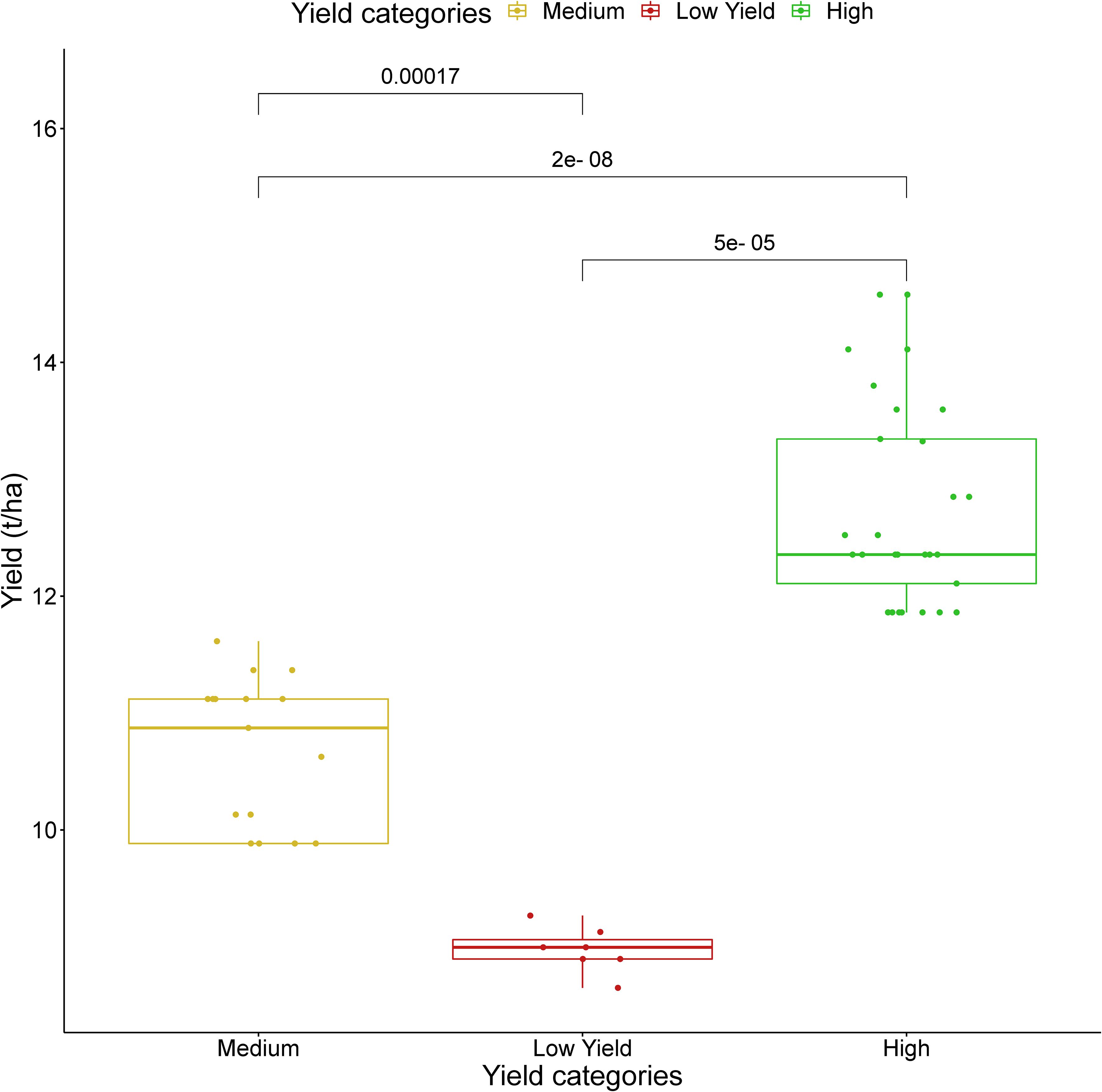
Figure 3. Yield and associated categories, varietal performance under different category (high, medium and low).
3.3 Effect of topography
Data indicated that in the high-yield category, the upland areas had 45% than the lowland areas which had 40% in the medium-yield mapping, plots had an equal distribution in the upland and lowland, at 35% on upland and 35% in lowland, the low-yield plots were predominantly in the lowland; lows accounted for 25% while upland accounted for 20% (
The chi-square test results were χ² = 0.85, P = 0.65, thus no statistically significant topographical relationship with the yield categories could be derived. A slight trend was observed, indicating that high-yield plots were generally located in upland areas, while low-yield plots were more commonly found in lowland regions Over 80% of lowland farmers use raised beds, which reduce waterlogging and improve the crop’s health, bridging the yield gap between uplands and lowlands
3.4 Effect of seed treatment
Although seed treatment did not have a statistically significant (χ² = 0.50 at p = 0.781) effect on yield across categories, it is noteworthy that a higher proportion of high-yield plots received seed treatment (62%; 29 plots) compared to those without treatment (48%; 18 plots). This suggests that seed treatment may still contribute to improved yields, even if the effect is not statistically significant (Figure 4, Table 1).
In comparison, seed-treated plots showed a 29.2% higher frequency of high yields, highlighting the practical benefit of seed treatment for improved yield outcomes (Figure 4, Table 1).
3.5 Effect of earthing up
Comparing the yield categories with earthing up, analyzed for the different methods of planting, clearly showed that RBS provided higher yields than FBS (Figure 5, Table 1). Higher yields was obtained with RBS while more importantly, there was a large reduction in yield without earthing up with FBS. Results clearly indicated that increased frequency of low yield plots and corresponding decrease in high yield plots under FBS, no earthing up conditions. Among high-yield plots, 45.45% practiced earthing up. This practice dropped to 22.73% in medium-yield plots and just 5.56% in low-yield plots, indicating a positive association between earthing up and yield performance. This gives an extremely significant relationship between earthing up and yield categories: χ² = 17.86, p = 0.003. In complete contrast, for RBS conditions, there was no significant effect of earthing up on yield, high yield frequencies occurring in all earthing up practices, χ² = 5.59, p = 0.050 (Figure 5, Table 1).

Figure 5. Performance of earthing up against different yield categories (a) yield categories vs earthing up; (b) yield categories vs earthing up (FBS); (c) yeld categories vs earthing up (RBS).
3.6 Effect of planting method
Significant differences in maize yields across categories of yield levels and planting methods applied (Figure 6, Table 1). At a general level, all farmers using the RBS were under the high-yield category, while farmers using the FBS remained under the low- and medium-category yields. The average yield under the raised bed system (RBS) was 12.7 t/ha, compared to 11.2 t/ha under the flat bed system (FBS), showing a significant 13.4% yield advantage with RBS. In the medium yield category, the difference was smaller, with RBS yielding 10.8 t/ha and FBS 10.1 t/ha (+6.9%) advantage in favor of RBS. In contrast, low yield farmers, RBS still held a slight advantage, with an average yield of 9.2 t/ha versus 8.9 t/ha for FBS, a 3.4% increase (Figure 6, Table 1).

Figure 6. Planting method and respective yield across the different yield group of farmers. (**= significant at P < 0.01;****= significant at P< 0.0001; NS stands for Non-significant).
3.7 Effect of crop geometry
Significant yield impact of row-to-row and plant-to-plant distances on yield categories can form the basis for gaining insights into the optimum spacing for maize cultivation (Figure 7, Table 1). The results of the chi-square test (χ² = 5.46, p = 0.487) did not show any significant relationship between the row-to-row distance and the yield categories. Interestingly, a row spacing of 50 cm was associated with better yields, as 48% of high-yield plots used this spacing compared to only 6% of low-yield plots. Specifically, on row-to-row spacing, the most dominant for high-yield plots was 22 cm, adopted by 43 plots out of 88, while 25 cm was the second most dominant, with 25 plots. For low-yield, it had varied the row-to-row spacing, with 22 and 25 cm spacings at 6 and 5 plots, respectively.
In contrast, plant-to-plant distance, 50 cm spacing was preferred since it had 47 plots out of 88 high-yielding plots, followed by 36 plots having 54 cm spacing. For medium yield, 34 plots out of 66 had a spacing of 22 cm, while 19 plots had 25 cm spacing. Low-yielding plots were less uniform, but 6 of the 18 had 22 cm spacing. That means, even though it is not significant statistically, planting maize at 22 cm plant-to-plant and 50 cm row-to-row normally gives higher yields. Regarding that, these observations further ascertain that the row spacing for optimal production in maize yield is also pretty evident that 22 cm plant-to-plant and 50 cm row-to-row are good spacing configurations toward high yield outcomes (Figure 7, Table 1).
3.8 Effect of tillage management
In high-yield plots, cultivators were used approximately 2.5 times, with total tillage operations ranging from 4 to 10 and a median of around 6 (Figure 8, Table 1). In the medium yield plots, cultivators were used about 2.5 times, and the total tillage operations ranged from 4 to 10, with a median of 7. This suggests that while medium-yield plots required more frequent tillage, the use of cultivators was relatively lower compared to high-yield plots. In contrast, low yield plots averaged about 2 applications of cultivators, while the total tillage operations ranged from 6 to 12, with a median of 10. This pattern indicates that too many tillage operations was not related to high yields, and perhaps even are counterproductive. More frequent tilling can reduce rather than increase yield potential, with an increase in the median number of tillage operations from 6 to 10, which means there is a 66.7% increase. (Figure 8, Table 1)

Figure 8. Frequency of cultivator use and total tillage operations under different yield categories: (a) High-yield, (b) Medium-yield, and (c) Low-yield farmer groups.
3.9 Effect of water management
Different yield categories showed varying trends in total irrigation hours per hectare per season for both RBS and FBS, as well as in the overall analysis (Figure 9, Table 1). Overall, high-yield plots received about 80–100 irrigation hours per hectare per season, compared to 70–90 in medium-yield plots and 60–80 in low-yield plots, indicating a positive correlation between irrigation duration and yield.

Figure 9. Irrigation (hours/ha/season) used under different yield categories, (A) average yield; (B) Raised bed system-RBS; (C) Flat bed system-FBS.
The results indicate a general positive correlation between irrigation and yield, with average irrigation hours per hectare per season at approximately 87.5, 80, and 78 for high-, medium-, and low-yield plots, respectively. Under RBS cultivation, high-yield plots required 70–90 hours, while medium- and low-yield plots needed around 80–100 and 90–110 hours, respectively. In contrast, under the RBS, average irrigation hours per hectare per season were approximately 74, 76.5, and 82.6 for high-, medium-, and low-yield plots, respectively. Conversely, under the FBS, higher yields demanded more irrigation, with high-yield plots requiring 70–90 hours per hectare per season, medium-yield plots 80–90 hours per hectare per season, and low-yield plots 70–80 hours per hectare per season. In the FBS, the average irrigation hours per hectare per season were approximately 76 for high-yield plots, 80 for medium-yield plots, and 72 for low-yield plots, indicating a less consistent relationship between irrigation and yield compared to RBS. RBS turns out to be more economical in water use if irrigation efficiency is compared; this can be attested to by the reduction of 15.5% in average irrigation hours for high yield plots. On the other hand, plots with medium yields decreased by 7.9% in irrigation hours within raised beds from 80 hours overall to 76.5, while plots with low yields increased by 5.8% from 78 hours overall to 82.6 hours in raised beds (Figure 9, Table 1).
3.10 Effect of nutrient management
Nutrient application rates varied significantly across yield categories and growth stages (Figure 10, Table 1). In high-yield plots, nutrient use at sowing was 49.68 kg/ha N, 111.66 kg/ha P, and 65.43 kg/ha K. At the knee-height stage, application was 37.63 kg/ha N, 53.85 kg/ha P, and 41.31 kg/ha K. By 80 DAS, 81.46 kg/ha of N was applied, followed by 96.57 kg/ha at 100 DAS. Overall, high-yield plots received a total of 243.85 kg/ha N, 165.51 kg/ha P, and 106.74 kg/ha K. Meanwhile, medium and low yield plots required similar total amounts of nitrogen but were less efficient in distribution across growth stages. Medium yield plots demanded 243.61 kg/ha of N, 164.44 kg/ha of P, and 124.35 kg/ha of K, and low yield plots 249.4 kg/ha of N, 251.68 kg/ha of P, and 142.61 kg/ha of K.
On the other hand, low-yield plots applied 52.1% more phosphorus and 33.6% more potassium than high-yield plots on average. High yields appear to be best achieved with a balanced application of approximately 243.85 kg/ha of nitrogen (N), 165.51 kg/ha of phosphorus, and 106.74 kg/ha of potassium (Figure 10, Table 1).Besides, there are certain secondary and micronutrient, like Zn and S (Sulphur), which highly influence the yields obtained. Plots with high yield required 11.58 kg/ha of Zn and 22.00 kg/ha of S, while those plots with medium yield required 9.59 kg/ha of Zn and 15.00 kg/ha of S, and plots with low yield required 8.47 kg/ha of Zn and 12.00 kg/ha of S. Indicating that high-yield plots used 20.7% more Zn and 46.7% more S as opposed to medium yield plots. Besides, high-yield plots utilized 36.7% more Zn and 83.3% more Sulphur than low-yield plots (Figure 10, Table 1).
3.11 Principal component analysis
The low yield groups were significantly related to the lower level of application of N, P, and K at sowing, at knee height, 80 DAS, and after 100 DAS (Figure 11). More specifically, low yield plots applied 49.68 kg/ha N at sowing, 37.63 kg/ha at knee height, 81.46 kg/ha at 80 DAS, and 96.57 kg/ha after 100 DAS. In high-yield plots, application is much more balanced in views, posting 243.85 kg/ha of N, 165.51 kg/ha of P, and 106.74 kg/ha of K for a proper spread of nutrients. A reduction in total irrigation to an average of 78 hours per hectare per season as compared to 87.5 hours in high-yield plots (-12.6% decrease), highlighting the potential impact of reduced water input on yield.
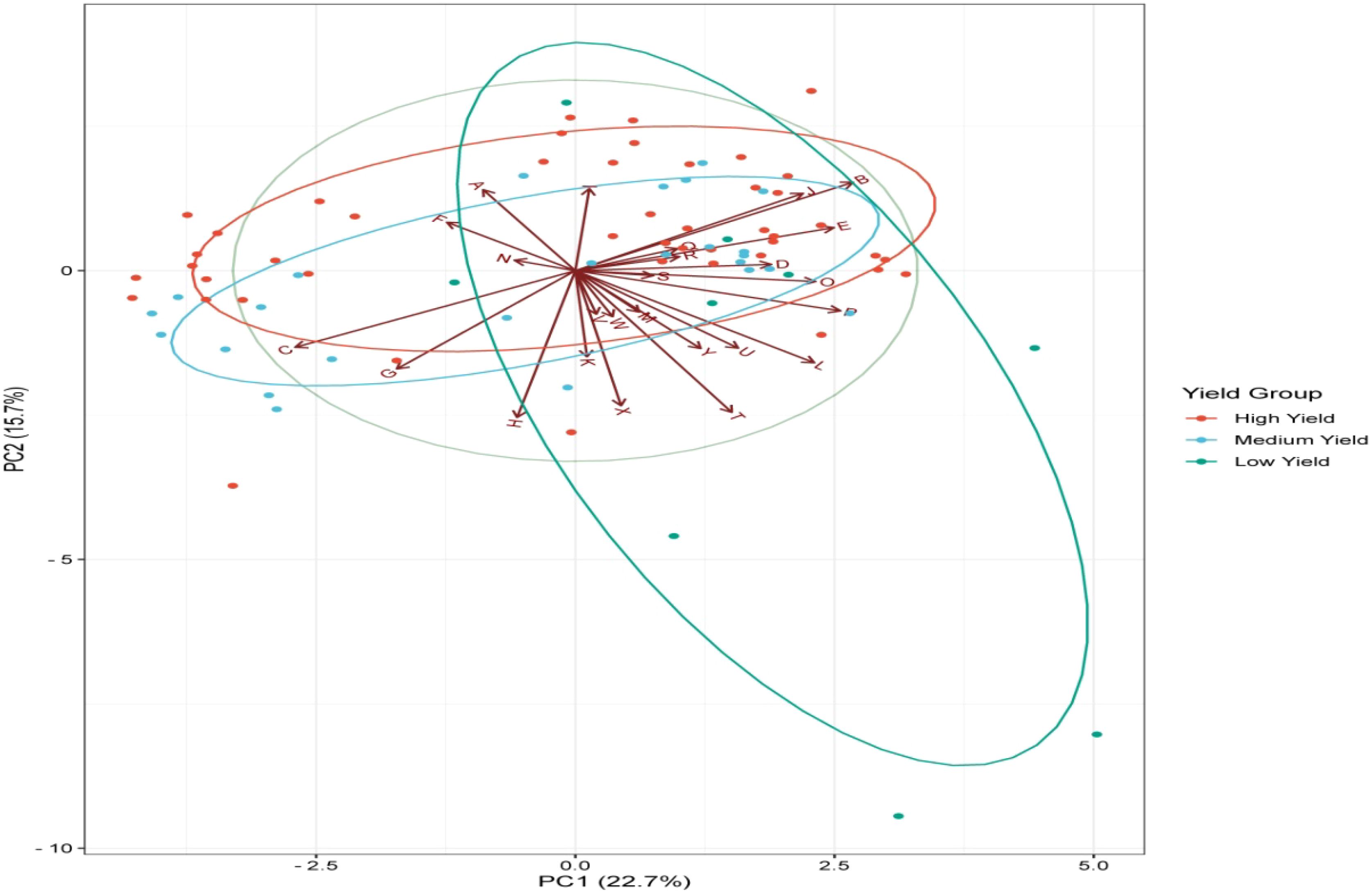
Figure 11. Principal components under yield categories1.
The plant-to-plant (PP) and row-to-row (RR) spacings were often suboptimal. Most high-yield plots followed a spacing of 22 cm PP and 50 cm RR. Additionally, low-yield plots used the cultivator less frequently averaging 2 times compared to 2.5 times in high-yield plots while performing more total tillage operations, with a median of 10 versus 6 in high-yield plots, representing a 66.7% increase (Figure 11).
4 Discussion
4.1 Sowing window
Maize sown between October 25 and November 7 achieved the highest yields, often exceeding 12 t/ha and peaking above 14 t/ha. Yields declined with later sowing, dropping to 10–13 t/ha for November 8–21 and 9–12 t/ha for November 22–December 5, indicating the optimal sowing window is likely the last week of October to the first week of November (Figure 12, Table 2). This provides some indication, perhaps, of what might be an optimum sowing window for maize. Further delays than this date can result in yields that are progressively lower due to several reasons such as shortening day length, cooler temperatures, and increasing the relative adverse weather risk over germination and early growth (Zahnd et al., 2023; Johnson and Martinez, 2018). These conditions might include slower growth rates and increased susceptibility to pests and diseases, reduced photosynthetic efficiency (Graham and Patterson, 1982), and finally result in the failure of the plant to bring forth high yields (Figure 2).

Table 2. Comparison of agronomic factors across yield categories and planting methods in maize cultivation.
4.2 Yield and varieties
High-yielding varieties, including Grover 4455, P 3355, Srikar 1818, and Vaishnavi 5577, averaged 10 t/ha. Medium-yield varieties produced around 9 t/ha, while low-yield ones averaged about 7.5 t/ha. P3355 showed yield consistency across farms, appearing in both high and medium-yield categories, thus indicating a stable and adaptive genotype suitable under diverse agronomic conditions. It may be that some cultivars under the high-yielding category perform well due to their inherent potential for greater productivity (Figure 3), better resistance or tolerance to certain pests and diseases, and adapting better to this favorable environment (Tilman et al., 2002). On the other hand, poor performance in some could arise due to genetically inadequacy (Kirina et al., 2025), higher susceptibility, or poor management practices (Brown et al., 2019; Kumar and Patel, 2021).
4.3 Topography
The topography in the distribution of yield classes shows that more high-yielding plots were found in upland areas than in lowland areas, and low-yielding plots were most common in the lowland areas rather than in the upland areas (Table 2). At low-lying areas may be made more suitable for cultivation by RBS, as it is otherwise prone to waterlogging, thereby affecting root health and nutrient uptake (Yang et al., 2023). Probably, in view of the practice of planting on raised beds in lowland areas, this reduces the yield gap between these topographies (Lee and Martinez, 2017; Martinez and Singh, 2016).
4.4 Seed treatment
The analysis did not identify any significant association between seed treatment and yield categories, χ² = 0.50, p = 0.781. Those plots with seed treatment had a higher frequency of the high yield category as compared to those plots with no seed treatment (Figure 4, Table 2). Even if this effect may not be statistically significant, the treated seeds promote better vigor in seedlings, which improves resistance against diseases (Reed et al., 2022), encourages early plant establishment, and finally helps in realizing superior yields (Rodriguez and Wang, 2020). While these benefits do not always yield massive increases in yield, they are important in the maintenance of overall plant health and productivity (Govindraj et al., 2017; Thomas and Rodriguez, 2018).
4.5 Earthing-up
The earthing-up practice exhibited a notable correlation with the yield categories, particularly within different planting methods. Generally, RBP was superior compared to FBP, irrespective of whether earthing-up was done (Figure 5) High frequency proportion of less yield was exhibited under FBP system while under low yield, there are fewer plots available and an increase in them takes place significantly (χ²=17.86, p=0.003). On the other hand, under RBP conditions, the earthing up has no influence on yield variation (χ²=5.59, p=0.050) since high yield frequencies remain in the same way constant with or without earthing-up (Figure 5, Table 2). These results evidently indicated that although RBP inherently supports higher yield due to improved drainage and root health, earthing up results in optimization of yield in FBP by enhancing soil aeration and root development (Jones and Singh, 2019; Patel and Kumar, 2020).
4.6 Planting methods
Planting methods have a critical impact on maize yield, with RBP producing better yields than FBP in all categories of yield (Figure 6). The yield advantage with RBP may be attributed to several agronomic benefits accrued from improved drainage (Duvick, 2005), better root development, and enhanced nutrient utilization (Derpsch and Friedrich, 2009). Previous research confirms these observations, citing that RBP provided better aeration conditions and reduced problems of waterlogging, which are very critical for maize growth (Sahrawat et al., 2010; Dossou-Yovo and Zougmoré, 2017).
Moreover, planting on raised beds can realize better irrigation management, therefore enhancing water use efficiency where there is limited supply of water resources (Govaerts et al., 2007). This method allows the exact quantity of water to reach the root zone, thus reducing potential loss and increasing the efficiency of water use (Martinez and Singh, 2016). This is because such a RBP system can also promote better application of fertilizers and other inputs that are applied before planting for better nutrient uptake and overall health of the plants (Sayre et al., 2005). In contrast, FBP, although easier and less labor-intensive, is generally associated with poor water and nutrient management, hence lower yields. The soil structure is often compacted in FBP, and this might affect the growth of the roots and reduce the nutrients and water available to the plants, thus lower yields (Govaerts et al., 2007).
4.7 Crop geometry
The effect of row-to-row and plant-to-plant distances on yield categories explains how optimization of spacing in maize cultivation works (Figure 7). A spacing of 50 cm for rows and 22 cm for plants tends to support higher yields, with a notable proportion of plots showing high yields at these spacing (Figure 7). Such spacing probably ensure maximum light interception, least competition for nutrients and water, and better general health of the plants, even though statistical tests did not show significant differences (Hernandez and Singh, 2017; Singh and Zhao, 2018).
4.8 Tillage management
High-yield plots had moderate tillage, with cultivator use around 2.5 times and a median of 6 total operations. Medium-yield plots used cultivators twice, with a median of 7 operations, while low-yield plots also used cultivators twice but had heavier tillage, with a median of 10 operations. The impact of the use of cultivators remained unexplained and statistically non-significant, but there is a clear indication that higher yields do not correspond with excessive tillage operations; on the contrary, they might be counterproductive in terms of tilling, cause destruction of soil structure, increase the risk of erosion, and deplete soil organic matter (Figure 8). Moderate tillage would help in the maintenance of soil health and structure and promote optimal root growth for maximum nutrient uptake (Smith and Johnson, 2019; Zhang and Li, 2020).
4.9 Water management
Overall, irrigation showed a clear positive relationship with yield across both RBS and FBS systems (Figure 9). High-yield plots required 80–100 hours/ha/season, medium-yield plots (70–90 hours/ha/season), and low-yield plots (60–80 hours/ha/season). Notably, raised bed planting achieved high yields with less water 70–90 hours/ha/season compared to 80–100 hours/ha/season in FBP highlighting its greater irrigation efficiency. This clearly showed that planting using the raised bed system is efficient for water-use purposes, especially about increasing the soil structure and its retention capacity for water, thus cutting down hours needed for repeated irrigation (Majeed et al., 2015). Efficient irrigation methods are essential in realizing increased yields, particularly in areas with limited water availability (Williams and Singh, 2018; Choudhury et al., 2017).
4.10 Nutrient management
High-yield plots achieved better results through balanced and efficient nutrient (NPK) use, along with higher applications of zinc and sulfur. Medium and low-yield plots applied similar or even higher total nutrients but with less efficiency, highlighting that proper timing and balanced nutrient management, including secondary nutrients, are key to maximizing yield. Findings show that for the best outcome in yield, nutrient applications must be in balance (Figure 10, Table 2). Else, it leads to the leaching of these excess or injudiciously used fertilizers, degrading the environment and less than optimum performance of crops (Garcia et al., 2019; Chen et al., 2020).
4.11 Principal component analysis
PCA based on agronomic data showed key information about yield results. This analysis demonstrated the majority of variance to be explained, with PC1 by 22.7% and PC2 by 15.7%. The results identified planting configuration as vital, as the variety > planting method> tillage > nutrient application > irrigation hours > topography > spacing > earthing-up > seed treatment in order have contributed to yields (Figure 11). Key were Planting methods and cultivation practices, more specifically, number of cultivators used and total tillage operations, which clearly pointed to the fact that large attention should be paid to the proper preparation of the soil (Evans and Sadler, 2008). Good irrigation management, expressed as total irrigation hours per hectare, came out essential in maintaining an adequate water supply throughout crop growth stage. This emphasizes the importance of integrated agronomic practices to grow maize to its optimum yield, considering well-planned plant arrangements, efficient tillage and irrigation management, and precise nutrient applications (Jaidka et al., 2019; Sanchez, 2010). These findings underscore the interaction of several factors in determining the outcome of yields and therefore call for a holistic approach in the optimization of all aspects of maize cultivation in realizing high yields. There needs to be this kind of comprehensive approach towards solving the complex problems of maize production if agriculture is to be sustainable (Liu et al., 2020; Sharma and Kumar, 2021).
5 Policy recommendation and implementation
Policy recommendations to enhance winter maize production under adverse climatic conditions include promoting optimal sowing windows (October 25th to November 7th) and high-yielding varieties such as Grover4455 and Srikar1818 to maximize yields (Figure 13). Additionally, training farmers on integrated agronomic practices, including efficient irrigation, balanced nutrient management, and appropriate spacing and tillage methods, is crucial. Offering subsidies for seed treatments and promoting raised bed planting can further improve plant health and reduce waterlogging risks. Strengthening agricultural extension services to disseminate research findings and best practices ensures that farmers have access to the latest innovations and techniques for sustainable maize production.
6 Conclusion
The integration of timely planting, high-yielding varieties, and appropriate planting techniques significantly enhances winter (Rabi) maize productivity in eastern India. Sowing between October 25 and November 7 consistently resulted in the highest yields (12–14 t/ha), whereas delays beyond November 22 led to a noticeable decline to 9–12 t/ha, reflecting yield reductions of up to 25%. Varieties such as Srikar 1818 and P 3355 posted mean yields of 10 t/ha, while types DKC-9165 yielded only 7.5 t/ha, demonstrating a 33% yield advantage with superior hybrids Planting in raised beds was also superior to flat beds by a 13.4% yield benefit (12.7 t/ha vs 11.2 t/ha), particularly useful in lowland situations. P3355 presence in both high and medium yield groups highlights its stability and adaptability. Seed treatment raised the incidence of high-yielding plots by 20.7%, and earthing up was found to be related to 45.45% of high-yielding plots as against only 5.56% in low-yielding plots. Ideal spacing (50 cm between rows and 22 cm between plants) was more common in high-yielding plots, while over-tillage (12 or more operations) was found in 66.7% of low-yielding fields. Effective irrigation in raised beds lowered water consumption to 74 hours, saving 15.5% over the entire average of 87.5 hours/ha/season in high-yield plots. Principal component analysis (PCA) confirmed that sustainable improvements in winter maize yields (+25%) higher can be achieved through an integrated approach combining optimal sowing time, improved varieties, raised bed planting, efficient irrigation, and balanced nutrient management.
Data availability statement
The original contributions presented in the study are included in the article/Supplementary material. Further inquiries can be directed to the corresponding authors.
Ethics statement
Ethical review and approval was not required for the study on human participants in accordance with the local legislation and institutional requirements. Written informed consent from the participants was not required to participate in this study in accordance with the national legislation and the institutional requirements.
Author contributions
RJ: Conceptualization, Methodology, Project administration, Writing – review & editing. SD: Conceptualization, Visualization, Writing – original draft, Writing – review & editing. VM: Conceptualization, Funding acquisition, Investigation, Methodology, Project administration, Supervision, Visualization, Writing – original draft, Writing – review & editing. RKSo: Project administration, Writing – review & editing. RNS: Formal analysis, Methodology, Project administration, Writing – review & editing. IR: Funding acquisition, Project administration, Writing – review & editing. SuK: Data curation, Methodology, Writing – review & editing. SP: Investigation, Methodology, Software, Writing – review & editing. SM: Formal analysis, Methodology, Resources, Software, Validation, Visualization, Writing – review & editing. KS: Investigation, Methodology, Writing – review & editing. SS: Investigation, Methodology, Writing – review & editing. RKSi: Investigation, Methodology, Resources, Visualization, Writing – review & editing. SeK: Funding acquisition, Investigation, Methodology, Supervision, Writing – review & editing. PK: Formal analysis, Funding acquisition, Investigation, Resources, Software, Writing – review & editing. GK: Data curation, Formal analysis, Methodology, Project administration, Writing – review & editing. AL: Investigation, Methodology, Project administration, Software, Writing – review & editing. AC: Investigation, Methodology, Project administration, Supervision, Writing – review & editing. AD: Methodology, Supervision, Writing – review & editing. AJ: Conceptualization, Funding acquisition, Project administration, Writing – review & editing. DT: Conceptualization, Software, Writing – review & editing. SS: Investigation, Methodology, Software, Supervision, Writing – review & editing.
Funding
The author(s) declare that financial support was received for the research and/or publication of this article. The authors gratefully acknowledge the financial and technical support provided by the Government of Bihar under the CRA Program (I7014.01). We also extend our sincere thanks to the Indian Council of Agricultural Research (ICAR), CGIAR, and all associated donors for their generous contributions, which were instrumental in supporting this research and publication.
Acknowledgments
We acknowledge the farmers for providing their time, resources, sharing their experiences and expertise. All the field technicians are highly acknowledged.
Conflict of interest
The authors declare that the research was conducted in the absence of any commercial or financial relationships that could be construed as a potential conflict of interest.
The author(s) declared that they were an editorial board member of Frontiers, at the time of submission. This had no impact on the peer review process and the final decision.
Generative AI statement
The author(s) declare that no Generative AI was used in the creation of this manuscript.
Publisher’s note
All claims expressed in this article are solely those of the authors and do not necessarily represent those of their affiliated organizations, or those of the publisher, the editors and the reviewers. Any product that may be evaluated in this article, or claim that may be made by its manufacturer, is not guaranteed or endorsed by the publisher.
Supplementary material
Supplementary material The Supplementary Material for this article can be found online at: https://www.frontiersin.org/articles/10.3389/fagro.2025.1562623/full#supplementary-material.
Footnotes
- ^ ("Yield t/Ha (A)" represents maize yield in tons per hectare. "PP Distance (cm) (B)" and "RR Distance (cm) (C)" detail plant-to-plant and row-to-row distances. "Number of Cultivators Used (D)" and "Total Number of Tillage (E)" record the number of cultivators and tillage operations. "Total Irrigation hrs/ha (F)" specifies total irrigation hours per hectare. Nutrient application is detailed at different growth stages: "N At Sowing (kg/ha) (G)," "N Knee Height (kg/ha) (H)," "N 80 DAS (kg/ha) (I)," and "N After 100 DAS (kg/ha) (J)," with these stages repeated for nitrogen, phosphorus, and potassium in columns "K" through "R." "N (kg/ha) (S)," "P (kg/ha) (T)," and "K (kg/ha) (U)" represent the total amounts of nitrogen, phosphorus, and potassium applied per hectare. Micronutrient applications include "Zinc (kg/ha) (V)," "Sulfur (kg/ha) (W)," and "Boron (kg/ha) (X)." "Vermicompost (kg/ha) (Y)" shows the amount of vermicompost used).
References
Brown R., Byerlee D., and Jayne T. (2019). Varietal performance of maize under different yield categories. J. Agron. 48, 475–486.
Brown A. J. and Lee C. P. (2019). Evaluation of maize varieties in different agro-ecological zones. J. Plant Breed. Crop Sci. 49, 125–135.
Cassman K. G., Dobermann A., Walters D. T., and Yang H. (2003). Meeting cereal demand while protecting natural resources and improving environmental quality. Annu. Rev. Environ. Resour. 28, 315–358. doi: 10.1146/annurev.energy.28.040202.122858
Chen F., Zhang F., and Li H. (2020). Efficient nutrient management practices for sustainable maize production in China. J. Integr. Agric. 19, 573–583.
Choudhury B. U., Mohanty S., and Kumar M. (2017). Irrigation scheduling for maize in Bihar. J. Agrometeorology 19, 232–241.
Derpsch R. and Friedrich T. (2009). Global overview of conservation agriculture adoption. Proc. 4th World Congress Conserv. Agriculture..
Dossou-Yovo E. and Zougmoré R. B. (2017). Impact of planting methods on maize yield in sub-Saharan Africa. Int. J. Agric. Sustainability 15, 254–268.
Duvick D. N. (2005). The contribution of breeding to yield advances in maize (Zea mays L.). Adv. Agron. 86, 83–145. doi: 10.1016/S0065-2113(05)86002-X
Evans R. G. and Sadler E. J. (2008). Methods and technologies to improve efficiency of water use. Water Resour. Res. 44, W00E04. doi: 10.1029/2007WR006200
FAO (2023). FAOSTAT statistical database (Food and Agriculture Organization of the United Nations). Available at: http://www.fao.org/faostat/en/data/QC (Accessed November 14, 2024).
Garcia M., Andrade F. H., and Fereres E. (2019). Nitrogen management and maize yield. Field Crops Res. 242, 107580.
Govaerts B., Sayre K. D., and Deckers J. (2007). A minimum data set for soil quality assessment. Geoderma 137, 277–283.
Govindraj M., Rao S. P., and Singh J. (2017). Seed treatments for enhanced germination and vigor in maize. Indian J. Agric. Res. 51, 329–337.
Graham D. and Patterson B. D. (1982). Responses of plants to low, nonfreezing temperatures: Proteins, metabolism, and acclimation. Annu. Rev. Plant Physiol. 33, 347–372. doi: 10.1146/annurev.pp.33.060182.002023
Hernandez J. A. and Singh S. (2017). Optimal spacing for maize cultivation: A review. Field Crops Res. 203, 63–72.
Jaidka M., Bathla S., and Kaur R. (2019). “Improved technologies for higher maize production,” in Maize: production and use. Ed. Hossain A. (IntechOpen). doi: 10.5772/intechopen.88997
Johnson R. and Martinez G. (2018). Effects of delayed sowing on maize yield. Crop Sci. J. 55, 189–196.
Jones C. A. and Singh J. (2019). The role of earthing up in maize yield optimization. J. Agron. Crop Sci. 205, 487–496.
Kirina T., Supit I., Groot A., Ludwig F., and Demissie T. (2025). Projected climate change impacts on potato yield in East Africa. Eur. J. Agron. 166, 127560. doi: 10.1016/j.eja.2024.127560
Kumar R. and Patel S. R. (2021). Enhancing maize productivity through varietal selection and agronomic practices. J. Agric. Sci. 164, 501–510.
Kumari S., Prakash R., and Kumar P. (2020). Influence of tillage and earthing up methods on yield and economics of maize (Zea mays L.) under rainfed conditions. J. Pharmacognosy Phytochem. 9, 205–209.
Lee C. and Martinez J. (2017). Topographical effects on maize yield in diverse agro-ecological zones. Geoderma 305, 44–53.
Liu Y., Zhang S., and Li X. (2020). Principal component analysis for identifying key factors affecting maize yield. Agric. Syst. 178, 102761.
Majeed A., Muhmood A., Niaz A., Javid S., Ahmad Z. A., Shah S. S. H., et al. (2015). Bed planting of wheat (Triticum aestivum L.) improves nitrogen use efficiency and grain yield compared to flat planting. Crop J. 3, 118–124. doi: 10.1016/j.cj.2015.01.005
Martinez J. and Singh V. (2016). Mitigating waterlogging through raised bed planting. Soil Tillage Res. 163, 88–96.
Patel N. and Kumar P. (2020). Comparative analysis of raised bed and flat bed planting systems for maize. Crop Sci. J. 60, 3002–3010.
Reed R. C., Bradford K. J., and Khanday I. (2022). Seed germination and vigor: Ensuring crop sustainability in a changing climate. Heredity 128, 407–416. doi: 10.1038/s41437-022-00497-2
Rodriguez J. and Wang L. (2020). Evaluating the benefits of seed treatments for maize. J. Crop Prot. 134, 104233.
Sahrawat K. L., Wani S. P., and Rego T. J. (2010). Managing natural resources for improving rainfed agriculture in Asia. Plant Soil 335, 65–78.
Sanchez P. A. (2010). Tripling crop yields in tropical Africa. Nat. Geosci. 3, 299–300. doi: 10.1038/ngeo853
Sayre KD, Limon-Ortega A, and Govaerts B. (2005). Experiences with permanent bed planting systems CIMMYT/Mexico. In: Roth CH, Fischer RA, and Meisner CA (eds) Evaluation and performance of permanent raised bed cropping systems in Asia, Australia and Mexico. Proceedings of a workshop held in Griffith, Australia. ACIAR Proceedings 121, pp 12–25
Sharma R. C. and Kumar R. (2021). Assessing the impact of agronomic practices on maize yield in India. Agric. Sci. 12, 457–468.
Shiferaw B., Prasanna B. M., Hellin J., and &Bänziger M. (2011). Crops that feed the world 6. Past successes and future challenges to the role played by maize in global food security. Food Secur. 3, 307–327.
Singh S. and Zhao Y. (2018). Effects of plant spacing on maize yield components. J. Agric. Sci. 156, 755–765.
Smith D. L. and Johnson L. F. (2019). Tillage practices and their impact on maize yield. Soil Tillage Res. 192, 150–160.
Thomas G. and Rodriguez J. (2018). Seed treatment impacts on maize seedling vigor. Seed Sci. Technol. 46, 265–276.
Tilman D., Cassman K. G., Matson P. A., Naylor R., and Polasky S. (2002). Agricultural sustainability and intensive production practices. Nature 418, 671–677. doi: 10.1038/nature01014
Tuti M. D., Kumar R. M., Sreedevi B., Bandumula N., Kuchi S., Bandeppa G. S., et al. (2022). Sustainable intensification of a rice–maize system through conservation agriculture to enhance system productivity in southern India. Plants 11, 1229. doi: 10.3390/plants11091229
Vanlauwe B. and Giller K. E. (2006). Popular myths around soil fertility management in sub-Saharan Africa. Agriculture Ecosyst. Environ. 116, 34–46. doi: 10.1016/j.agee.2006.03.016
Williams J. R. and Singh V. P. (2018). Optimizing irrigation for maize yield improvement. Agric. Water Manage. 202, 1–10.
Yang L., Li N., Liu Y., Miao P., Liu J., and Wang Z. (2023). Updates and prospects: Morphological, physiological, and molecular regulation in crop response to waterlogging stress. Agronomy 13, 2599. doi: 10.3390/agronomy13102599
Zahnd C., Arend M., Kahmen A., and Hoch G. (2023). Microclimatic gradients cause phenological variations within temperate tree canopies in autumn but not in spring. Agric. For. Meteorology 331, 109340. doi: 10.1016/j.agrformet.2023.109340
Keywords: optimal sowing, high-yield varieties, agronomic practices, climate, winter maize
Citation: Jat RK, Durgude S, Meena VS, Sohane RK, Singh RN, Reddy IR, Kumar S, Pazhanismy S, Meena SK, Sharda K, Singh S, Singh RK, Kumari S, Kumar P, Kumar G, Lenka AK, Chaurasiya A, Das A, Jha AK, Tripathi DP and Sagar S (2025) Unlocking winter maize potential: pioneering on-farm strategies for resilient yields in challenging climates. Front. Agron. 7:1562623. doi: 10.3389/fagro.2025.1562623
Received: 17 January 2025; Accepted: 30 April 2025;
Published: 02 June 2025.
Edited by:
Debankur Sanyal, University of Arizona, United StatesReviewed by:
Jozsef Kiss, Szent István University, HungarySharif Ahmed, International Rice Research Institute (IRRI), Philippines
Copyright © 2025 Jat, Durgude, Meena, Sohane, Singh, Reddy, Kumar, Pazhanismy, Meena, Sharda, Singh, Singh, Kumari, Kumar, Kumar, Lenka, Chaurasiya, Das, Jha, Tripathi and Sagar. This is an open-access article distributed under the terms of the Creative Commons Attribution License (CC BY). The use, distribution or reproduction in other forums is permitted, provided the original author(s) and the copyright owner(s) are credited and that the original publication in this journal is cited, in accordance with accepted academic practice. No use, distribution or reproduction is permitted which does not comply with these terms.
*Correspondence: Raj Kumar Jat, ci5qYXRAY2dpYXIub3Jn; Vijay Singh Meena, dmlqYXlzc2FjLmJodUBnbWFpbC5jb20=; Shubham Durgude, cy5kdXJndWRlQGNnaWFyLm9yZw==; Sunita Kumari Meena, c3VtZWVuYTY2QGdtYWlsLmNvbQ==
 Raj Kumar Jat
Raj Kumar Jat Shubham Durgude
Shubham Durgude Vijay Singh Meena
Vijay Singh Meena RK Sohane3
RK Sohane3 Illathur R. Reddy
Illathur R. Reddy S. Pazhanismy
S. Pazhanismy Sunita Kumari Meena
Sunita Kumari Meena Asheesh Chaurasiya
Asheesh Chaurasiya Anup Das
Anup Das